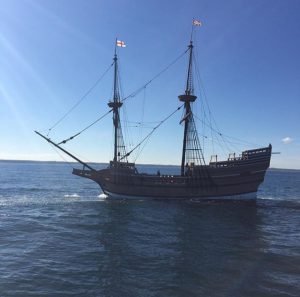Over the next few years, you’ll hear more and more about the 400th anniversary of the Puritans and Separatists who sailed on Mayflower in 1620. We know them as “The Pilgrims.” In 1620, the Pilgrims landed at Plymouth in Massachusetts Bay, where they found harsh weather, an unfamiliar land, and where they were responsible for the care of (initially) 102 people in their new Colony.
William Bradford, the Governor of Plymouth Colony, is one of the few individuals who documented his life in the early years of the settlement. Governor Bradford was the longest-serving governor of the colony and is well known for his book, Of Plymouth Plantation, written between 1630 and 1651.
The New England Historic Genealogical Society is happy to be involved in planning the 2020 anniversary activities and we will be running excerpts from Governor Bradford’s book, Edward Winslow’s Good Newes in New England (1624), and Winslow and Bradford's joint work Mourt's Relation, written in 1620–21. This ongoing series about the Pilgrims, Mayflower, and the individuals from whom many of us descend should shed some light on this time in New England history.
"[Now] it was conceived by the workmen and all, that she was sufficient, and they might proceed without either fear or danger."
We know the story of Mayflower carrying 102 brave souls to the New World, but do you know about Speedwell? This vessel, captained by a man named Reynolds, was a ship that was to accompany Mayflower on its journey. In the paragraph below, taken from Bradford’s book, the Governor describes the ‘lesser ship’ and those who had to turn back.
Being thus put to sea, they had not gone far but, the master of the lesser ship, complained that he found his ship so leaky as he durst not put further to sea till she was mended. So the master of the bigger ship (called Mr. Jones) being consulted with, they both resolved to put into Dartmouth and have her there searched and mended, which accordingly was done, to their great charge and loss of time and a fair wind. She was here thoroughly searched from stem to stem, some leaks were found and mended, and now it was conceived by the workmen and all, that she was sufficient, and they might proceed without either fear or danger. So with good hopes from hence, they put to sea again, conceiving they should go comfortably on, not looking for any more lets of this kind; but it fell out otherwise. For after they were gone to sea again about 100 leagues without the Lands End, holding company together all this while, the master of the small ship complained his ship was so leaky as he must bear up or sink at sea, for they could scarce free her with much pumping… So after they had took out such provision as the other ship could well stow, and concluded that both what number and what persons to send back, they made another sad parting; the one ship going back for London and the other was to proceed on her voyage.” – Chapter VIII
We hope these ongoing blog posts will educate Mayflower enthusiasts, descendants, and history lovers about the founders of “America’s Hometown” of Plymouth, Massachusetts.
To learn more about the passengers – their lives and their legacy – visit Mayflower.AmericanAncestors.org.
Share this:
About Sarah Dery
Sarah Dery, who lives in Concord, is the Research and Library Manager at American Ancestors/NEHGS; she has been with the Society since 2017. She supports the researchers and genealogists on the Research and Library teams, managing correspondence with constituents, organizing research information, and applying her genealogical knowledge in assisting our clients – both in-person and digitally. Sarah is a graduate of Rhode Island College in Providence and has a B.A. in anthropology and English Literature. Her interest in anthropology stems from her participation in a week-long archaeology dig at James Madison’s Montpelier in Virginia. Her family ancestry and expertise include Rhode Island, Connecticut, and French-Canada.View all posts by Sarah Dery →
